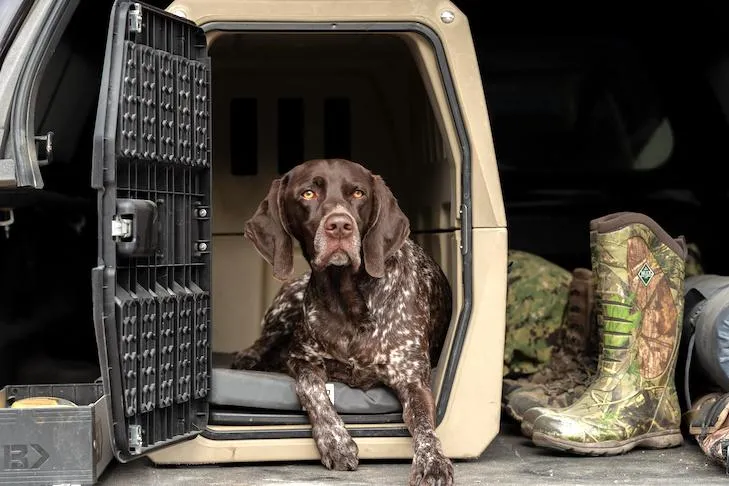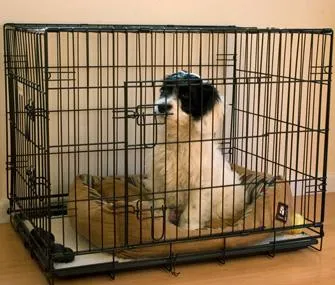Your Ultimate Guide to Traveling Crates
Whether you’re moving your pet across the country or taking Fido on a family road trip, a traveling crate is an essential part of safe and stress-free transportation. As any pet owner knows, crating helps keep animals secure during travel. But with so many crate options on the market, how do you choose the right one? In this article, I’ll cover everything you need to know to find the perfect traveling crate.
Why Use a Traveling Crate?
The number one reason for using a crate is safety. It protects your pet from being injured or distracting the driver during transportation. A crate also prevents animals from roaming freely in the vehicle, where they could be in danger from activity like sudden stops or turns. From my experience spending long hours in the car with pets, crating helps control stress too. Pets often feel more secure enclosed in a crate versus loose in an open vehicle.
Choosing the Right Size
Crate size is crucial – it shouldn’t be too big or too small. As a general guide, your pet should be able to stand up and turn around comfortably inside. Measure your dog from nose to tail, then add a few inches for space. For cats, choose a large crate to allow them to stretch and move. If getting a collapsible crate, buy the next size up so it doesn’t feel cramped once assembled. I made the mistake once of getting a crate my dog barely fit into – he seemed anxious the whole ride!
Material and Durability
Popular crate materials include plastic, metal, and fabric. Plastic is lightweight and easy to clean but may break down faster. Metal is sturdy and long-lasting but heavier. Fabric is softer on paws but less durable. Consider how much you’ll use the crate – occasional trips or frequent moves. For long-term traveling, invest in a rugged metal or thick plastic model. Interior padding is also important for comfort. Look for cushions and mattress liners made from cozy, machine-washable fabrics.
Collapsible Versus Hard-Sided
Collapsible crates fold up compactly for storage when not in use, making them quite portable. However, some pets don’t like the enclosed feeling as much as a rigid crate. Hard-sided crates don’t collapse but provide a more den-like environment. Weigh whether portability or security are priorities. For occasional trips, a foldable crate works well. For extended travel, a sturdy hard-sided model provides a more stable home-away-from-home.

Accessories and Add-Ons
Consider extras that can make travel more pleasant: adjustable mesh panels for better air flow and visibility; spill-proof trays or pads for accidents; cozy blankets and chew toys for entertainment. A car seatbelt attachment secures the crate safely during transport. I also stock a first aid kit, pet food, leash, poop bags, and water for long journeys. Many crates come with add-on kits for all these staples. Do your research – accessories can really enhance your pet’s travel experience.
Test Runs at Home
Before a big trip, get your pet used to their new crate with short training sessions. Toss treats inside and praise/pet your dog when they enter voluntarily. Leave the crate door open and place toys and food nearby. Gradually increase exercise and playtime inside to positive associations. When comfortable, try short practice car rides. I’ve found this familiarizes pets and eases stress on the real journey. It’s better than springing a crate on them for the first time in the car!
Tips for Crating in the Car
On the road, keep crates securely fastened with seatbelts or cargo straps to prevent injuries from sudden stops. Provide blankets, music or toys to occupy pets. For cats, use open top crates or carriers to alleviate anxiety. Consider resizable soft-sided crates that cling to seats. Stop regularly for bathroom breaks, exercise, and water. Overall, most pets adapt politely if they feel safe, calm, and cared for.
Frequently Asked Questions
How do I introduce my cat or dog to a crate for the first time?
Gradual positive reinforcement is key. Make the crate inviting with toys and treats. Allow your pet inside voluntarily without forcing them. Close the door only briefly at first while they eat treats. Slowly increase time inside over days. Always praise and reward for calm behavior.
What if my pet gets carsick?
Consult your vet about anti-nausea aids, especially for long trips. Drive slowly and choose back seat areas with fresh air. Provide ventilation but avoid drafts near your pet. Offer sippy water or ice chips. Frequent bathroom breaks can help too. With preparation and patience, most pets adapt.

How do I choose between plastic, metal, or fabric?
Consider your budget, needs, and pet. Plastic is affordable but less durable for heavy chewers. Metal withstands tough use but is heavy. Fabric provides comfort but less security. All have pros – choose based on expected use and your pet’s personality.
What size crate should I get for my puppy?
Puppies need room to grow. Get one 2-3 times their current size to last until adulthood. Measure from nose to tail then add 3-4 inches all around. Monitor size periodically as rescinding may become necessary. Avoid crowding as it causes anxiety.
Final Thoughts
Proper crate training takes time, patience and positive reinforcement. But it ensures safe travels while helping reduce stress for pets. Do your research and listen to your pet’s needs and behavior. With the right preparations using a crate, you can both enjoy quality time together on the road! Safe tripping and happy travels to all pet owners and their furry friends.
Factors to Consider When Choosing a Traveling Crate
| Feature | Details |
|---|---|
| Size | Measure your pet and choose a crate that allows them to stand up and turn around comfortably. |
| Ventilation | Properly ventilated crates help keep air circulating to prevent overheating. |
| Durability | Heavy-duty metal or thick plastic crates withstand scratching and chewing better than thin plastic or wire variants. |
| Ease of Cleaning | Removable plastic pans, grill floors and wipe-clean surfaces simplify hygiene. |
| Portability | Look for folding or collapsible crates that are lightweight for easy transport in vehicles. |
| Comfort | Padded or plush interiors provide added comfort during longer trips or overnight stays. |
FAQ
-
What size traveling crate should I get for my pet?
The proper size depends on your pet’s breed and size. Generally, you want enough room for them to stand up and turn around comfortably. But not so big that they can soil one end and not reach the other. Measure your pet and check crate size guidelines.
-
How do I crate train my pet?
Beginning crate training is basically making the crate a cozy safe space. Feed meals inside and give treats/toys for going in. Keep initial sessions short until they’re fine being in there alone. Praise calm behavior and don’t scold accidents. Be patient, it could take days or weeks.

-
What features should I look for in a quality traveling crate?
Factors like sturdy construction, strong hinges/latches, and ventilation are important for safety. No sharp edges. Look for plastic trays or washable beds to catch accidents. Wheel or shoulder strap options aid transporting. And perhaps a divider to adjust size as your pet grows.
-
How do I keep my pet comfortable in their crate during travel?
Bring water, a water bottle for long trips. Pack toys/chews and their bed to make it feel homey. Consider plastic sheeting under bedding in case of accidents. Bring paper towels too. Smaller frequent meals can prevent nausea. Don’t feed a large meal right before or during travel. And if they seem carsick, pull over ASAP!
-
Should I crate my pet when leaving them home alone?
It’s kinda a debate among experts. But for many pets, an appropriately-sized crate can provide den-like security when home alone. It prevents resource guarding of toys/furniture and house soiling. As long as they aren’t crated excessively long term with no exercise or attention. Moderation is best when deciding this for your own pet.
-
What pet accidents or issues could arise during travel?
Nervous pets may have accidents in their crate from stress. Be prepared with stuff to clean it and disinfect the crate after. Collars or IDs could potentially get caught on something. So use harnesses for travel instead. And of course carsickness is a risk depending on the pet and their tolerance for moving in a vehicle. Pull over immediately if they seem unwell!
-
Is it safe to let my pet roam freely in the vehicle?
Certainly not while driving! Even smaller pets could potentially distract you or harm themselves in an accident. Always crate or tether them in the backseat or trunk area with proper ventilation. It’s also risky to let a pet run freely at rest stops with potential animal/people interactions you can’t monitor and them getting lost. For their protection, keep leashes on at all times outside the crate.

-
What can go wrong during air travel with pets?
Air carriers have lost or injured animals before due to mistakes. Delays or cancelled flights are always possible too. Make sure your pet is properly secured in an FAA-approved hard-sided kennel that is correctly labeled. Consider pet air transport services instead of cabin/hold if very worried. You may want to purchase pet travel insurance as well given the risks of air transport compared to a vehicle. But lots of animals do make the trip just fine each year too, it appears.
